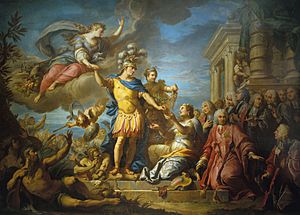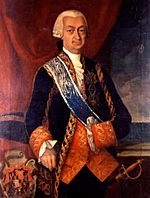Action of 28 November 1751 facts for kids
Quick facts for kids Action of 28 November 1751 |
|||||||
|---|---|---|---|---|---|---|---|
| Part of the Spanish-Barbary Wars | |||||||
 Anonymous engraving depicting the final battle between the Dragón and the Danzik |
|||||||
|
|||||||
| Belligerents | |||||||
| Commanders and leaders | |||||||
| Strength | |||||||
| 2 ships of the line | 2 ships of the line | ||||||
| Casualties and losses | |||||||
| 3 killed 25 wounded |
194 killed 90 wounded 1 ship of line destroyed |
||||||
| 50 European slaves freed | |||||||
The Action of 28 November 1751 was an important naval battle. It happened near Cape St. Vincent in the Atlantic Ocean. Two Spanish warships, led by Captain Pedro Fitz-James Stuart, fought two Algerine ships. These Algerine ships were called corsairs. Corsairs were like pirates who attacked Christian merchant ships. They would capture the ships and take their crews as slaves. This battle, from November 28 to December 2, 1751, was a big win for Spain.
The Algerine corsairs came from Algiers. They were known for raiding ships and coastal towns. They would capture people to sell them into slavery. This was a major part of the economy for the Barbary states, which were part of the Ottoman Empire. Spain, being a Christian country, was often a target. The Spanish Navy was sent to stop these powerful Algerine ships. When the two fleets met, they were evenly matched. Each side had two large warships called "ships of the line."
Captain Fitz-James Stuart spotted the Algerine corsairs. He wanted to stop them before they could escape. The Algerine ships fired first, starting the fight. But then they tried to run away. They thought they couldn't win against the well-trained Spanish crews. The Spanish ships chased them. Fitz-James Stuart's ship, the Dragón, caught up to the Algerine flagship, the Danzik. The other Algerine ship, the Castillo Nuevo, managed to escape. The Dragón and Danzik fought for two days. The Danzik was badly damaged. Its crew and captured Christian slaves were rescued. Then, the Danzik was set on fire because it was too damaged to sail. Fitz-James Stuart returned to Spain as a hero.
Contents
Why the Battle Happened
Europe had just finished a huge war called the War of the Austrian Succession. This war was about who would rule a large empire. Spain had been part of this war. Its navy had fought many battles, like one near Havana. This meant Spanish sailors were very experienced.
After the war, a peace treaty was signed. Spain was safe from other European countries. But the Spanish navy leaders knew something important. They wanted their sailors to stay skilled. So, they needed to keep practicing and fighting.
The Barbary corsairs had been a problem for Christian countries for a long time. They would attack ships and capture people. Sometimes, they even raided villages on the coast. These captured people were then sold as slaves. This was a big part of the Barbary states' economy. Spain wanted to end this threat. So, the Marquis of Ensenada ordered two groups of Spanish warships to patrol the Barbary coast. Their goal was to fight the corsairs and keep the Spanish sailors busy. Before November 1751, the Spanish captured smaller corsair ships. But no big battles happened. Around this time, two powerful Algerine corsairs sailed near Spain. They were attacking Christian merchant ships and taking their crews as slaves.
The Battle Begins
On November 28, Captain Pedro Fitz-James Stuart was sailing near the Spanish coast. He was looking for two Barbary ships that had been bothering merchant ships. Captain Stuart commanded the 60-gun ship Dragón. The other Spanish ship was the América, led by Captain Luis de Córdova y Córdova.
They spotted two corsair ships about 52 leagues (a long distance) off the coast. These ships belonged to the Regency of Algiers. They were the 60-gun Danzik, which was the Algerine flagship, and the 54-gun Castillo Nuevo. The Danzik was commanded by Mohammed Chirif.
Captain Stuart sailed closer to find out who they were. By 5 p.m., they were very close. Suddenly, the Danzik raised the Algerine flag. It fired its cannons fiercely at the Dragón. Then, it immediately tried to escape. It was clear the Algerines knew they were outmatched. They tried to trick the Spanish and get away. Chirif ordered his ships to sail southwest. But the Dragón and América chased them closely.
The Chase and Final Fight
The chase lasted for two days. The Castillo Nuevo managed to break away from the Danzik. It escaped its Spanish pursuers. Captain Stuart told his ships to ignore the Castillo Nuevo. They continued to chase only the Danzik. Chirif tried to avoid Spanish cannon fire by sailing into the wind. This made it hard for the Spanish ships to open their lower gunports.
However, the Spanish ships could still fire their front cannons. These shots damaged the Danzik's ropes and sails. This made the Algerine ship slow down. The Spanish ships got close enough to board. For a moment, the Danzik lowered its flag, meaning it surrendered. But Chirif's crew encouraged him. He raised the flag again and kept fighting until sunset. Both sides stopped fighting because the sea was too rough.
The next day, the Spanish warships attacked again. The Dragón and Danzik fought a fierce duel. The Danzik suffered many casualties and heavy damage. Finally, Chirif had no choice. He lowered his flag again and surrendered for good. Captain Stuart sent his men to take control of the ship.
The Spanish had very few losses: only 3 killed and 25 wounded. The Algerine ship had 194 killed and about 90 wounded. The Danzik was too damaged to sail back to port. So, 320 prisoners, including Chirif, were taken off the ship. Also, 50 Christian slaves, mostly Dutch sailors, were rescued. After everyone was off, the Danzik was set on fire.
What Happened Next
The Spanish ships returned to port. Captain Fitz-James Stuart was celebrated by the Spanish Navy. The Dutch slaves were allowed to go back to their home country. The Spanish sailors received "prize money" from the valuables found on the Danzik.
The Castillo Nuevo, the Algerine ship that escaped, continued to attack Christian ships. Even after this defeat, and other Spanish victories, the Barbary corsairs kept bothering Spanish merchant ships. In 1775, the King of Spain, Charles III, wanted to strike a big blow to the Algerians. He ordered an attack to capture the port of Algiers. This was a major center for the Barbary slave trade.
This attack, with 20,000 men and 74 warships, failed badly. It didn't stop the Algerians from continuing to enslave Christians. But King Charles never gave up. In 1783, he ordered Antonio Barceló to bombard Algiers. This first bombing didn't do much damage to either side. The Spanish court was angry, but Charles was even more determined.
Charles tried to make a peace deal with the Ottoman Empire. He wanted them to stop the corsairs. But the ruler of Algiers refused. Charles realized that war was the only way. On July 12, 1784, a huge fleet attacked Algiers. This fleet included ships from Spain, Portugal, and other allies. They caused a lot of damage to Algiers' defenses. The Algerine forces were weakened. They were forced to make peace with Spain. This agreement made them stop large-scale piracy. This battle marked the end of the Barbary corsairs' major activities for a while.
Order of Battle
| Ship | Commander | Navy | Guns | Casualties | |||||
|---|---|---|---|---|---|---|---|---|---|
| Killed | Wounded | Total | |||||||
| Dragón | Captain Pedro Fitz-James Stuart | 60 | 3 | 25 | 28 | ||||
| América | Captain Luis de Córdova y Córdova | 60 | 0 | 0 | 0 | ||||
| Danzik (captured) | Corsair Mohammed Chirif (POW) | 60 | 194 | 90 | 284 | ||||
| Castillo Nuevo (escaped) | Corsair Mahamud Rais | 54 | 0 | 0 | 0 | ||||
See Also
 In Spanish: Acción del 28 de noviembre de 1751 para niños
In Spanish: Acción del 28 de noviembre de 1751 para niños
- Antonio Barceló
- Barbary corsairs
- Spanish Navy



